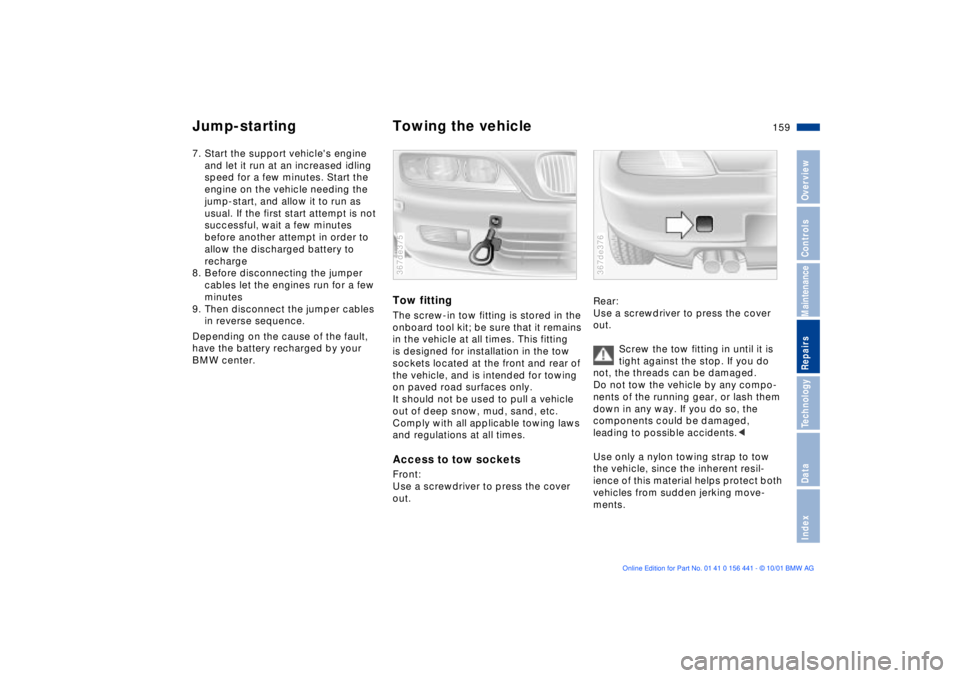Page 159 of 187

159n
IndexDataTechnologyRepairsMaintenanceControlsOverview
Jump-starting Towing the vehicle7. Start the support vehicle's engine
and let it run at an increased idling
speed for a few minutes. Start the
engine on the vehicle needing the
jump-start, and allow it to run as
usual. If the first start attempt is not
successful, wait a few minutes
before another attempt in order to
allow the discharged battery to
recharge
8. Before disconnecting the jumper
cables let the engines run for a few
minutes
9. Then disconnect the jumper cables
in reverse sequence.
Depending on the cause of the fault,
have the battery recharged by your
BMW center.
Tow fittingThe screw-in tow fitting is stored in the
onboard tool kit; be sure that it remains
in the vehicle at all times. This fitting
is designed for installation in the tow
sockets located at the front and rear of
the vehicle, and is intended for towing
on paved road surfaces only.
It should not be used to pull a vehicle
out of deep snow, mud, sand, etc.
Comply with all applicable towing laws
and regulations at all times.Access to tow socketsFront:
Use a screwdriver to press the cover
out.367de375
Rear:
Use a screwdriver to press the cover
out.
Screw the tow fitting in until it is
tight against the stop. If you do
not, the threads can be damaged.
Do not tow the vehicle by any compo-
nents of the running gear, or lash them
down in any way. If you do so, the
components could be damaged,
leading to possible accidents.<
Use only a nylon towing strap to tow
the vehicle, since the inherent resil-
ience of this material helps protect both
vehicles from sudden jerking move-
ments.367de376
Page 161 of 187
161n
IndexDataTechnologyRepairsMaintenanceControlsOverview
Page 163 of 187
Overview
Controls and features
Operation, maintenance
Owner service procedures
Technical data
Index Advanced technology
163n
IndexDataTechnologyRepairsMaintenanceControlsOverview
Adaptive Transmission Control
(ATC)164
Airbags164
Automatic Stability Control plus
Traction (ASC+T)/Dynamic
Stability Control (DSC)165
Car radio reception166
Safety belt tensioner166
Technology
Page 165 of 187

165n
IndexDataTechnologyRepairsMaintenanceControlsOverview
The airbags located under the marked
covers inflate and unfold in a matter of
a few milliseconds. In this process they
tear through the designed breaking
points of the upholstered covers or
press them out.
Because the inflation process must be
virtually instantaneous, it is necessarily
accompanied by a certain amount of
ignition and inflation noise. The gas
required to inflate the airbags is not
dangerous, and it dissipates together
with the associated smoke.
The entire process is completed within
fractions of a second.Precision sensors monitor the number of
revolutions of the wheels. When
equipped with DSC, they also monitor
steering angle, lateral acceleration,
brake pressure and the movement of the
vehicle around its vertical axis.
If differences in the wheel speeds occur,
ASC+T recognizes the danger of wheel-
spin and reduces the drive torque. If
necessary, the system also responds
with additional applications of the brakes
at the rear wheels.
In addition, DSC permanently monitors
the vehicle's current operating condition
and compares it with an ideal condition
that is calculated from the sensor's
signals. If deviations from this occur
(understeering or oversteering, for
instance), DSC can stabilize the vehicle
in fractions of a second by adjusting
engine output and with the assistance of
braking intervention at individual wheels.
Within physically possible limits
dangerous skids can be prevented even
as they are just beginning.You may need some time to become
accustomed to this system's interven-
tion. However, it provides optimum
propulsive force and driving stability.
The braking intervention may be accom-
panied by a certain degree of noise.Airbags ASC+T/DSC
*
Page 167 of 187
167n
IndexDataTechnologyRepairsMaintenanceControlsOverview
Page 169 of 187
Overview
Controls and features
Operation, maintenance
Owner service procedures
Technical data
Index Advanced technology
169n
IndexDataTechnologyRepairsMaintenanceControlsOverview
Engine specifications170
Dimensions171
Weights172
Capacities173
Electrical system174
Drive belts174
Data
Page 171 of 187
171n
IndexDataTechnologyRepairsMaintenanceControlsOverview
Z3 roadster 2.5i, 3.0i Z3 coupe 3.0i
Length in (mm) 159.4 (4,050) 158.5 (4,025)
Width in (mm) 68.5 (1,740) 68.5 (1,740)
Height (unloaded) in (mm) 50.9 (1,293) 51.4 (1,306)
Wheelbase in (mm) 96.3 (2,446) 96.3 (2,446)
Track, front in (mm) 55.6 (1,413) 55.6 (1,413)
Track, rear in (mm) 58.8 (1,494) 58.8 (1,494)
Min. turning circle dia. ft (m) 32.8 (10.0) 32.8 (10.0)
Dimensions
Page 173 of 187
173n
IndexDataTechnologyRepairsMaintenanceControlsOverview
Capacities
Notes
Fuel tank
reserve gal. (liters)
gal. (liters)approx. 13.5 (approx. 51)
approx. 2.1 (approx. 8.0)Fuel specification: page 26
Windshield washer system/
Headlamp washer system quarts (liters) approx. 5.3 (approx. 5.0)For details: page 122
Cooling system including heating circuit quarts (liters) 11.1 (10.5) For details: page 125
Engine with oil filter renewal quarts (liters) 6.9 (6.5) "BMW High Performance
Synthetic Oil"
For details: page 124
Manual transmission, automatic
transmission and differentialÐ Lifetime fluid, no fluid change
required